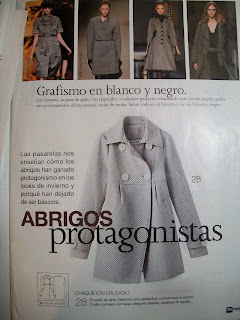I love Patrones coat patterns for several reasons, but I think the biggest reason is the sleeves. Not only are the designs super cute, but they fit so well if you are twiggy of the arm like me. I didn't bother with a muslin for this coat because my first Patrones coat fit so well. This one is from the same issue, design 28. Mine is made in a Vera Wang teal and navy tweed that I bought from Fabric.com last year, interfaced with silk organza (never again, that was way too much work), and lined with gold flannel-backed satin. It's cozy and just the right weight for early spring in New England, when you still need a heavy coat but don't need your 700 down fill wind and rain resistent coat. It's still cold but not Arctic cold at this time of year.
 |
| Patrones 285, No. 28 |
I think it should have been the same length as my raincoat, but because I used really bulky fabric (think afghan throw) the turn of cloth shrunk the coat quite a bit. You can see the difference between the pattern piece and front in this photo.
 |
| I lost about an inch in the bodice piece, which then affected the overall fit. |
Now, on to the coat. I did all the hand sewing for the interfacing during the week. I've been under the weather and I guess the upside of being at home and spacing out in front of the TV is that you can do that while mindlessly basting interfacing to fabric. On the downside, I am going to be really behind when I get back to the office this week.
 |
| At the end of a chilly Sunday morning walk. |
 |
| You can kind of see the curved front when the coat is closed. Also, let it be known that I am unable to pose for a photo without making some kind of goofy face. |
The turn of cloth (I'm blaming the coat's shortcomings on the super thick fabric) shortened the bodice and I don't think you can see it from the front, but definitely from the side. I would make this coat again in a lighter coating so that the bodice makes it over my bust. As it is, the skirt drapes from almost the fullest point, making the coat a little tent like.
 |
| If I stand with bad posture the tentiness isn't so pronounced. I'm also showing off one of my single welt pockets. |
 |
| Here it is from the back. It fits very well in the shoulders. |
 |
Photo showing lining and facing. I'm grateful for my steam iron that tamed everything and put it in its place.
The fabric was challenging to work with. It was so thick that I had to pull it through my sewing machine at some points. It also had to be interfaced. Being so loosely woven (it really is not unlike a granny square afghan throw in that respect), I didn't want to go through the effort of sewing a coat for it to just become a shapeless heap after one season. Because I basted organza to it, the basting stitches would get stuck in the feed dogs of my machine, further confounding the situation. Because I refuse to hand stitch unless absolutely necessary, bagging the lining was criminally frustrating. Luckily I have a steam iron that will beat the fluffiest fabric into submission because otherwise the fabric would have won and I would be posting picture of a shapeless pouf.
Despite the problems posed by the fabric (and ultimately, less than satisfying fit) I'm pretty happy with this coat. The look is very retro, and it's cozy without being too casual. And hopefully, nobody will know about the cutting mistake. Except for you.




















